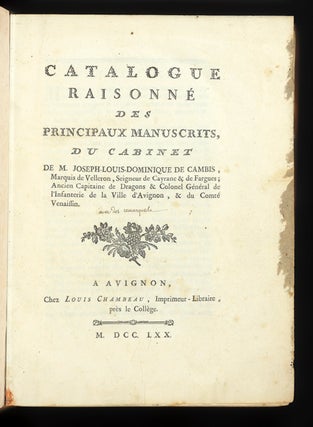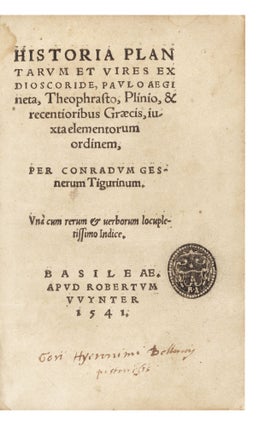Yi qie jing yin yi yin shuo wen jian 一切經音義引說文箋 [Annotations on the Quotations from Shuowen [jiezi] (Explain the Graphs to Unravel the Written Words) in Sounds & Meanings of All the Buddhist Scriptures].
14 juan in four vols. 8vo, orig. wrappers, orig. stitching. Jianling: Tian shi ding chu shi; Beijing: Wen kai zhai juan, 1924.
First edition of this study on quotations from Xu Shen’s (d. ca. 149) Shuowen jiezi [Explain the Graphs to Unravel the Written Words], the first dictionary of Chinese characters. We learn from Tian’s Preface that Sounds & Meanings refers to two different editions of this work: one is the edition by Xuanying (fl. 7th cent.), which is also known as Da Tang zhongjing yinyi [Sounds & Meanings of the Many Scriptures of the Great Tang]; the other is the more famous edition by Huilin (737-820).
Tian’s book compares quotes from Xu Shen’s Shuo wen jiezi from ca. 100 CE — quotes that Tian found in Xuanying’s and Huilin’s glosses on the Buddhist canon — to two recensions of Shuowen jiezi that date from the 10th century. His book is thus primarily a study of Shuowen jiezi. Regarding Shuowen jiezi, Françoise Bottéro writes, “For the first time, all the characters included in [a lexicographical] work were presented according to a new system of classification invented by the author. This is a tremendous achievement in the history of this non-alphabetical writing system” (Bottéro, “Ancient China,” in The Cambridge World History of Lexicography, ed. John Considine, p. 59). Shuowen jiezi is thus a landmark work in the history of Chinese lexicography and in the study of the structure of the Chinese script.
Shuowen jiezi was known and studied in the centuries following its composition, but the text became corrupted, and we have no reliable editions from this period. The earliest reliable recensions of Shuowen jiezi are the books by the brothers Xu Kai (916-91) and Xu Xuan (920-74). Tian used both recensions, and his notes are thus based on four books: the two editions of glosses to the Buddhist scriptures and the two editions of Shuowen jiezi. Tian’s book listed instances in which the quotes from Shuowen jiezi in the glossaries differ in their wording from the received text of the Shuowen jiezi as transmitted by the two Xu brothers. Tian’s purpose is to find instances where the original phrasing of Shuowen jiezi had eluded the Xu brothers, and thereby to produce a more reliable Shuowen jiezi text.
Tian’s book can be seen as a late addition to a trend in the philological study of Shuowen jiezi that began in the late 18th century, in the Qing period. At this time, the Shuowen jiezi was seen as a gateway to an earlier form of Chinese script — the so-called “small seal” [xiao zhuan] — and a seminal work from a period of flourishing classical scholarship that was much valued in the 18th and 19th centuries (so-called “Han learning,” named after the Han dynasty, under which Xu Shen and his peers lived and worked). The leading Republican intellectual Liang Qichao (1873-1929), remarked in 1923, the year before Tian published his book, on the exceptional place that studies of the Shuowen jiezi had played in Qing-period scholarship (Ori Sela, China’s Philological Turn, pp. 86-87). The book thus clearly remained on the horizon of intellectuals in the Republican period, Tian Qian among them.
Tian (1870-1926), is also representative of the last generation to reach maturity in the Qing period, in that he studied in Japan and this experience brought him in contact with historical Chinese books that otherwise might have escaped his attention. He writes that he encountered Huilin’s and Xuanying’s glossaries in Japan, and that was clearly the impetus for his work.
Fine set, preserved in a hantao.
Price: $2,950.00
Item ID: 7827

![Item ID: 7827 Yi qie jing yin yi yin shuo wen jian 一切經音義引說文箋 [Annotations on the Quotations from Shuowen [jiezi] (Explain the Graphs to Unravel the Written Words) in Sounds & Meanings of All the Buddhist Scriptures]. Qian 田潛 TIAN.](https://jonathanahill.cdn.bibliopolis.com/pictures/7827.jpg?width=768&height=1000&fit=bounds&auto=webp&v=1640384401)
![Yi qie jing yin yi yin shuo wen jian 一切經音義引說文箋 [Annotations on the Quotations from Shuowen [jiezi] (Explain the Graphs to Unravel the Written Words) in Sounds & Meanings of All the Buddhist Scriptures].](https://jonathanahill.cdn.bibliopolis.com/pictures/7827_2.jpg?width=320&height=427&fit=bounds&auto=webp&v=1640384401)



